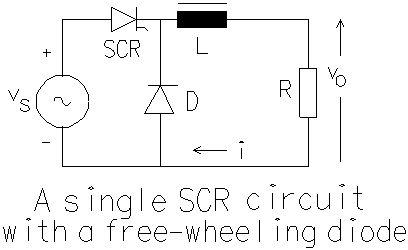
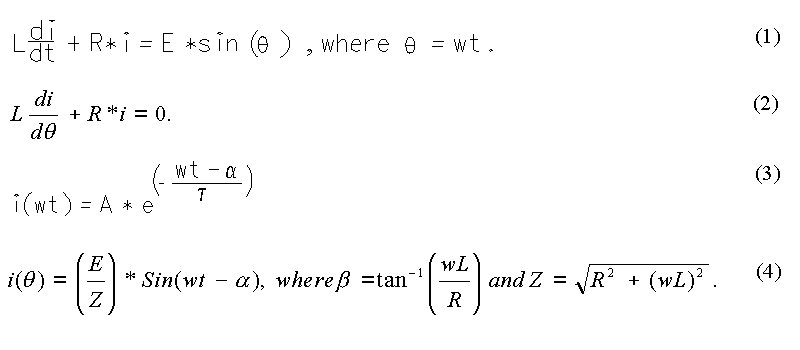
The total solution is the sum of both the complimentary and the particular solution for a < wt < p .
The difference in solution is in how the constant A in complementary integral is evaluated. In the case of the circuit without free-wheeling diode, i(a) = 0, since the current starts building up from zero when the SCR is triggered during the positive half-cycle. On the other hand, the current-flow is continuous, when there is a free wheeling diode. Since the input to the RL circuit is a periodic function, we expect that the response of the circuit should also be periodic. That means, the current through the load is periodic. It means that
i(a) = i(2p + a).
Since the current through the load free-wheels during p < q < (2p + a) , we get that,
i(q) = i(p) *exp[-(q - p)/t] , where t = wL/R.
We use ( q - p ) for the elapsed period in radians instead of q itself, since the free-wheeling action starts at q = p . From the total solution, we get i(p).
i(p) = A*exp(- p/t) + (E/Z)*sin (p - a).
To obtain A, the following steps are necessary. From the total solution, obtain an expression for i(a) by substituting a for q. From the expression for the free-wheeling period, obtain i(2p + a) by letting q = (2p + a) . Since i(a) = i(2p + a), we can obtain A to be:
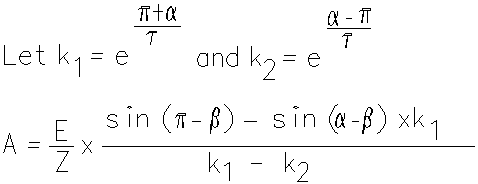
The voltage across the inductor is obtained to be
vL(q ) = vs(q) - R*i(q) , for a < q < p and
= - R*i(q) , for p < q < (2p + a) .
vs(q) = E*sin (q).
It is preferable to normalize vs with respect to E and the current with respect to E/R and then the only value that is required to be known for solving for the current is t. The applet shown below simulates this circuit. You have to key-in the ratio t in the text-field to the left of the button and the firing angle in degrees in the text-field to the right of the button and then click on the button next to it. Do not key-in a NaN.

* Half-wave Rectifier with a free-wheeling diode * A problem to find the SCR current VIN 1 0 SIN(0 340V 50Hz) XT1 1 2 5 2 SCR VP 5 2 PULSE(0 10 1667U 1N 1N 100U 20M) L1 2 3 31.8MH R1 3 0 10 D2 0 2 DNAME .MODEL DNAME D(IS=10N N=1 BV=1200 IBV=10E-3 VJ=0.6) * Subcircuit for SCR .SUBCKT SCR 101 102 103 102 S1 101 105 106 102 SMOD RG 103 104 50 VX 104 102 DC 0 VY 105 107 DC 0 DT 107 102 DMOD RT 106 102 1 CT 106 102 10U F1 102 106 POLY(2) VX VY 0 50 11 .MODEL SMOD VSWITCH(RON=0.0105 ROFF=10E+5 VON=0.5 VOFF=0) .MODEL DMOD D((IS=2.2E-15 BV=1200 TT=0 CJO=0) .ENDS SCR .TRAN 10US 60.0MS 20.0MS 10US .PROBE .OPTIONS(ABSTOL=1N RELTOL=.01 VNTOL=1MV) .END
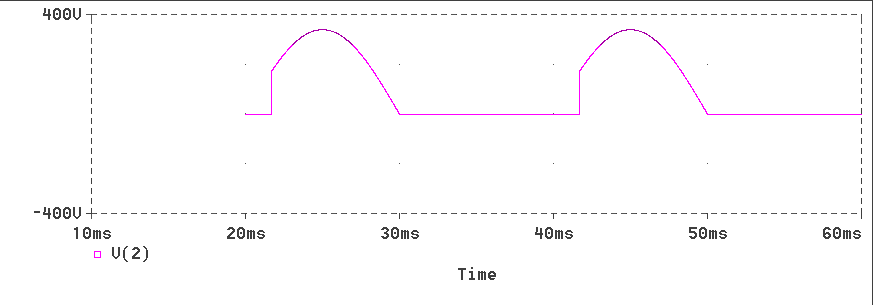
The waveform of voltage at the cathode of SCR
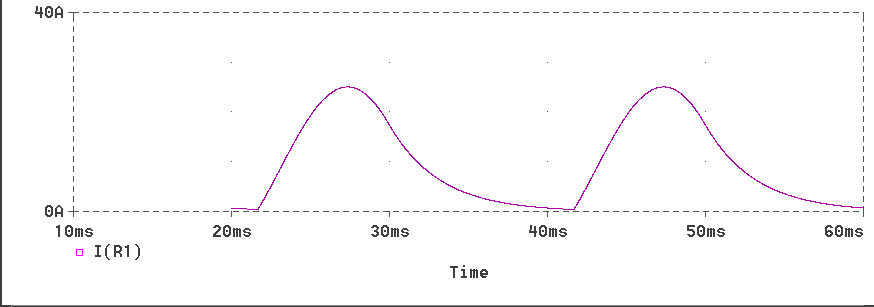
The waveform of current through the load

The waveform of voltage across the SCR
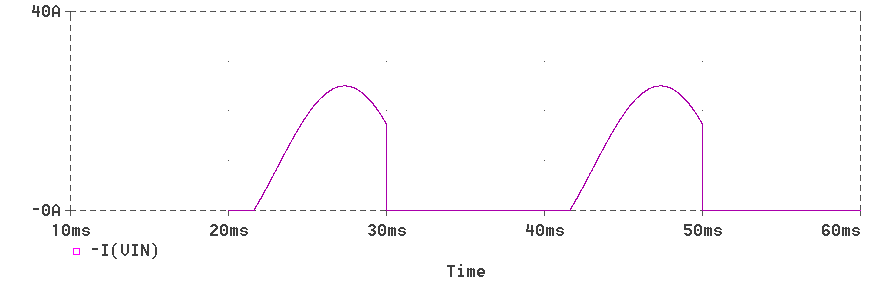
The waveform of current through the SCR
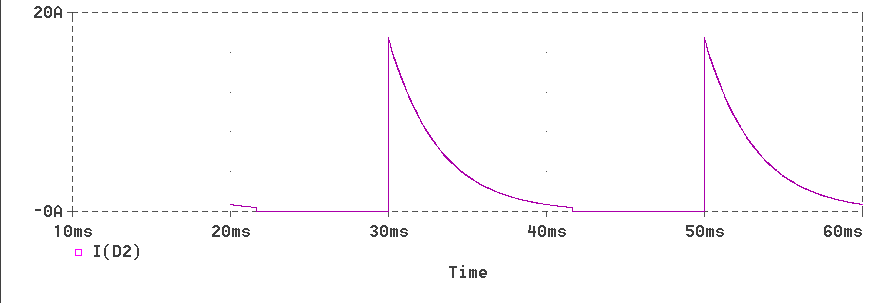
The waveform of current through the free-wheeling
diode
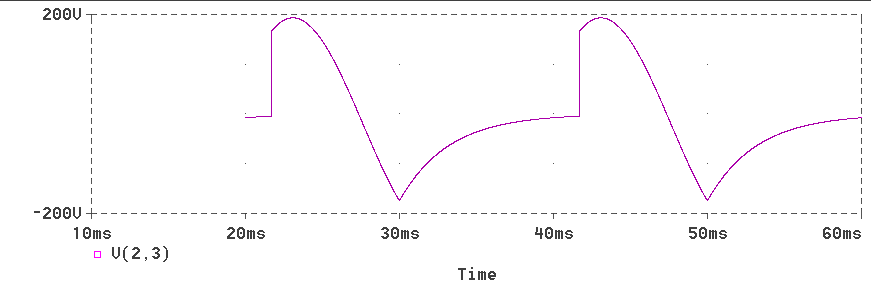
The waveform of voltage across the inductor
% Program to simulate the half-wave controlled rectifier circuit
% The circuit has a free-wheeling diode
% Enter the peak voltage, frequency, inductance L in mH and resistor R
disp('Typical value for peak voltage is 340 V')
peakV=input('Enter Peak voltage in Volts>');
disp('Typical value for line frequency is 50 Hz')
freq=input('Enter line frequency in Hz>');
disp('Typical value for Load inductance is 31.8 mH')
L=input('Enter Load inductance in mH>');
disp('Typical value for Load Resistance is 10.0 Ohms')
R=input('Enter Load Resistance in Ohms>');
disp('Typical value for Firing angle is 30.0 degree')
fangDeg=input('Enter Firing angle within range 0 to 180 in deg>');
fangRad=fangDeg/180.0*pi;
w=2.0*pi*freq;
X=w*L/1000.0;
if (X<0.001) X=0.001; end;
Z=sqrt(R*R+X*X);
tauInv=R/X;
loadAng=atan(X/R);
k1=exp(R*(pi+fangRad)/X);
k2=exp(R*(fangRad-pi)/X);
A=peakV/Z*(sin(pi-loadAng)+sin(loadAng-fangRad)*k1)/(k1-k2);
Ampavg=0;
AmpRMS=0;
Cur180=peakV/Z*sin(pi-loadAng)+A*k2;
for n=1:360;
theta=n/180.0*pi;
X(n)=n;
if (n<fangDeg)
cur=Cur180*exp(-(pi+theta)*tauInv);
Vind(n)=-R*cur;
iLoad(n)=cur;
Vout(n)=0;
VSCR(n)=peakV*sin(theta);
curSCR(n)=0;
diodecur(n)=cur;
Ampavg=Ampavg+cur*1/360;
AmpRMS=AmpRMS+cur*cur*1/360;
elseif ((n>=fangDeg) & (n<180))
cur=peakV/Z*sin(theta-loadAng)+A*exp(-tauInv*(theta-fangRad));
Ampavg=Ampavg+cur*1/360;
AmpRMS=AmpRMS+cur*cur*1/360;
Vind(n)=peakV*sin(theta)-R*cur;
iLoad(n)=cur;
Vout(n)=peakV*sin(theta);
VSCR(n)=0;
curSCR(n)=cur;
diodecur(n)=0;
else
cur=Cur180*exp((pi-theta)*tauInv);
Vind(n)=-R*cur;
iLoad(n)=cur;
Vout(n)=0;
VSCR(n)=peakV*sin(theta);
curSCR(n)=0;
diodecur(n)=cur;
Ampavg=Ampavg+cur*1/360;
AmpRMS=AmpRMS+cur*cur*1/360;
end;
end;
plot(X,iLoad)
title('The Load current')
xlabel('degrees')
ylabel('Amps')
grid
pause
plot(X,Vout)
title('Voltage at cathode')
xlabel('degrees')
ylabel('Volts')
grid
pause
plot(X,Vind)
title('Inductor Voltage')
xlabel('degrees')
ylabel('Volts')
grid
pause
plot(X,VSCR)
title('SCR Voltage')
xlabel('degrees')
ylabel('Volts')
grid
pause
plot(X,curSCR)
title('SCR Current')
xlabel('degrees')
ylabel('Amps')
grid
pause
plot(X,diodecur)
title('diode Current')
xlabel('degrees')
ylabel('Amps')
grid
AmpRMS=sqrt(AmpRMS);
[C,message]=fopen('hwavec2.dat','w');
fprintf(C,'Avg Load Cur=\t%d\tRMS Load Cur=\t%f\n',Ampavg,AmpRMS);
fclose(C)
The output file is re-produced below.
Avg Load Cur= 1.009749e+001 RMS Load Cur= 13.337142Next the plots obtained for the typical specified values are displayed.
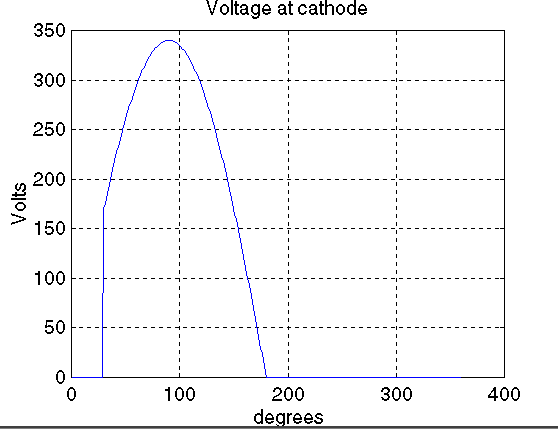
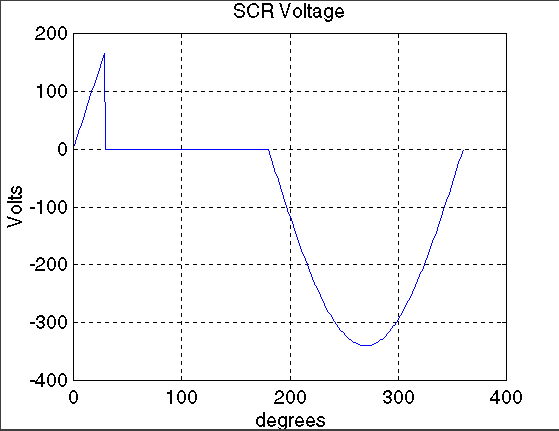


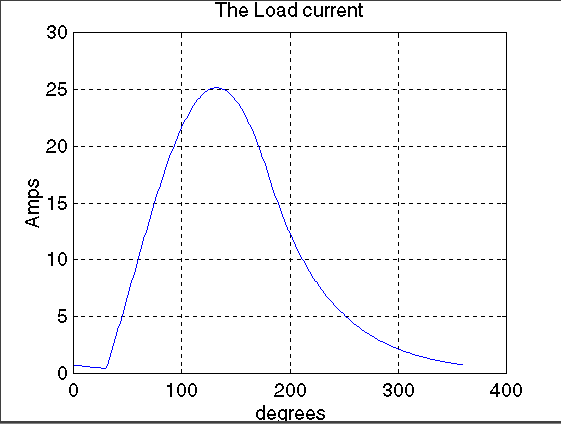
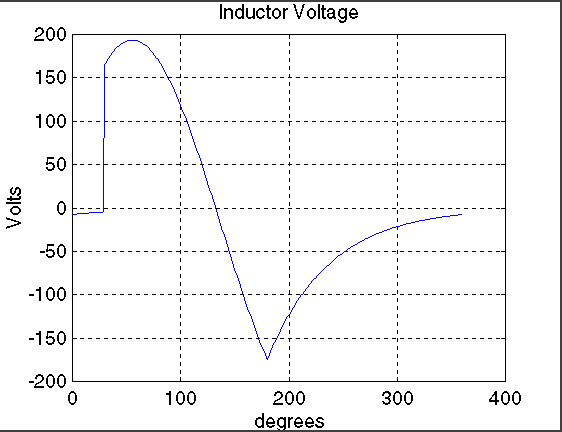
This page has described the operation of a half-wave rectifier wirh a free-wheeling diode. Next we take up the study of single-phase, full-wave, fully-controlled rectifier.